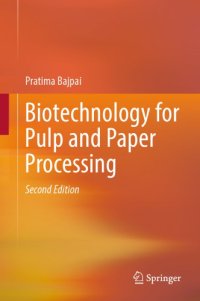
Ebook: Biotechnology for pulp and paper processing
Author: Bajpai Pratima
- Tags: Biotechnologie, Papier--Industrie--Aspect de l'environnement, Pâte à papier--Industrie--Aspect de l'environnement, Papier -- Industrie -- Aspect de l'environnement, Pâte à papier -- Industrie -- Aspect de l'environnement
- Year: 2018
- Publisher: Springer
- City: Singapore
- Edition: 2nd Edition
- Language: English
- pdf
6.2 Environmental Impact of Lipophilic Extractives6.3 Methods for Pitch Control; 6.3.1 Conventional Treatment; 6.3.2 Biological Treatment; 6.3.2.1 Use of Fungi; 6.3.2.2 Use of Enzymes; Hydrolytic Enzymes; Oxidative Enzymes; 6.4 Advantages, Limitations, and Future Prospects; References; 7 Bioretting; Abstract; 7.1 Introduction; 7.2 Methods for Retting; 7.3 Enzymes Used in Flax-Retting; 7.4 Application of Enzymes in Flax-Retting; 7.5 Effect of Enzyme-Retting on Fiber Yield and Properties; 7.6 Effect of Enzyme-Retting on Effluent Properties; References; 8 Biopulping; Abstract; 8.1 Introduction.;9.2.4 Cellobiohydrolase and Mannanase Blend Treatment9.2.5 Lignin Peroxidase, Manganese Peroxidase, and Laccase Treatment; 9.2.6 Pectinase Treatment; 9.2.7 Manganese Peroxidase, Laccase, and Pectinase Blend treatment; 9.3 Conclusions; References; 10 Biobleaching; Abstract; 10.1 Introduction; 10.2 Xylanase Enzymes; 10.2.1 Production and Properties of Xylanases; 10.2.2 Performance of Xylanases in Bleaching; 10.2.3 Effect of Xylanases on Pulp and Effluent Quality; 10.2.4 Mechanism of Bleaching; 10.2.5 Conclusion and Future Prospects; 10.3 Lignin-Oxidizing Enzymes.;8.2 Pulping Processes8.2.1 Mechanical Pulping; 8.2.2 Semichemical Pulping; 8.2.3 Chemical Pulping; 8.2.3.1 Kraft Process; 8.2.3.2 Sulfite Process; 8.3 Biomechanical Pulping; 8.4 Biochemical Pulping; 8.5 Organosolv Pulping; 8.6 Biopulping with Laccaseâ#x80; #x93; Mediator System; 8.7 Mechanism of Biopulping; 8.8 Advantages of Biopulping; 8.9 Limitations and Future Prospects; References; 9 Use of Enzymes in Mechanical Pulping; Abstract; 9.1 Introduction; 9.2 Effect of Different Enzymes; 9.2.1 Cellulase Treatment; 9.2.2 Xylanase Treatment; 9.2.3 Cellobiohydrolase (CBH I) Treatment.;This is the most comprehensive and up-to-date treatment of all aspects of biotechnology in the processing of pulp and paper. Each chapter covers a discrete process or technique, assessing the advantages and limitations of, as well as the prospects for, each.;4.3 Biotechnological Applications in Forestry4.3.1 Propagation; 4.3.2 Genetic Engineering; 4.3.3 Transgenesis; 4.3.4 Lignin Modification; 4.3.5 In Vitro Culture; 4.3.6 Stress Resistance; 4.3.6.1 Abiotic; 4.3.6.2 Biotic; 4.3.7 Tissue Culture; 4.3.8 RNA Interference; 4.3.9 Marker-Assisted Selection and QTL Mapping; References; 5 Biodebarking; Abstract; 5.1 Introduction; 5.2 Enzymes Used for Debarking; 5.3 Application of Enzymes for Debarking; 5.4 Advantages of Biodebarking; 5.5 Limitations and Future Prospects; References; 6 Biodepitching; Abstract; 6.1 Introduction.;Intro; Preface; Contents; List of Figures; List of Tables; 1 Introduction; Abstract; References; 2 Brief Description of the Pulp and Papermaking Process; Abstract; 2.1 Introduction; 2.2 Pulp and Papermaking Process; 2.2.1 Pulp Making Process; 2.2.2 Stock Preparation and Papermaking Process; References; 3 Tree Improvement; Abstract; 3.1 Introduction; 3.1.1 Forest Trees in the Age of Modern Genetics; 3.1.1.1 Genetic Altering of Trees; 3.1.1.2 Phytoremediation; References; 4 Biotechnology in Forestry; Abstract; 4.1 Introduction; 4.2 Historical Perspectives.
Download the book Biotechnology for pulp and paper processing for free or read online
Continue reading on any device:

Last viewed books
Related books
{related-news}
Comments (0)